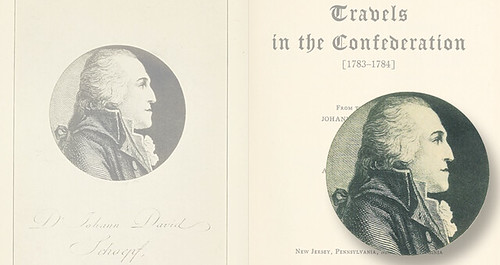
PREV ARTICLE
NEXT ARTICLE
FULL ISSUE
PREV FULL ISSUE
BOOKS FOR COLLECTORS OF U.S. COLONIAL COINAGE
In his March 11, 2016 Coin World column, John Kraljevich discusses bibliographies as a reference guide for the collector of U.S.
colonial coinage. -Editor

Johann David Schöpf’s Travels in the Confederation has the first reference to John Chalmers’ Annapolis mint. A Colonial coin collector’s library is never complete. Once standard references are acquired and all the auction catalogs for famous collections are safely in hand, curious specialists can expand their libraries in every possible direction: forward, backward, and outward. Forward: There is no time like the present. The last year has seen two new works published by the Colonial Coin Collectors Club. Chris McDowell’s biography on Abel Buell has placed one of the artisan geniuses of the Confederation and early Federal period in an all-encompassing context. Syd Martin’s new book on French colonial copper coinage shines a spotlight on one of the corners of Colonial numismatics that has been dark for too long. The Internet, including archival sites like Google Books and the Newman Numismatic Portal, keeps making research easier than it’s ever been, enabling prospective authors to gather data and refine their arguments in months. While there is no substitute for dusty libraries, shoe leather, and looking at thousands of coins, look for the Information Superhighway to keep making it easier to stock your shelves with new print works every year. Backward: Most collectors would agree that the modern era of research on Colonial coins started when Sylvester Crosby published The Early Coins of America in 1875. Some books are vital to understanding the coins and why they circulated in America, like Jonathan Swift’s Drapier’s Letters, which described the creation and rejection of William Wood’s halfpence. Early travelogues are important sources, like Johann David Schöpf’s Travels in the Confederation, which provides the first reference to John Chalmers’ Annapolis mint. Magazines and newspapers in both Europe and America include descriptions or even illustrations of coins while they still circulated. In the 1850s, as coin collecting was blossoming in America, Colonial coins became a topic of interest, and periodicals like Historical Magazine offered space to collectors like Jeremiah Colburn and Augustus Sage to share what they had learned. Outward: For as broad as the field of numismatic literature is, it is ever expanding. Push beyond the confines of books written about coins by coin people, and you’ll find archaeologists recording coins they’ve dug, economists discussing the circulation of foreign coins or the prominence of paper money, and famous biographers hanging flesh on the founders without whom these coins wouldn’t exist. To read the complete article, see:

Wayne Homren, Editor The Numismatic Bibliomania Society is a non-profit organization promoting numismatic literature. See our web site at coinbooks.org. To submit items for publication in The E-Sylum, write to the Editor at this address: whomren@gmail.com To subscribe go to: https://my.binhost.com/lists/listinfo/esylum All Rights Reserved. NBS Home Page Contact the NBS webmaster 
|